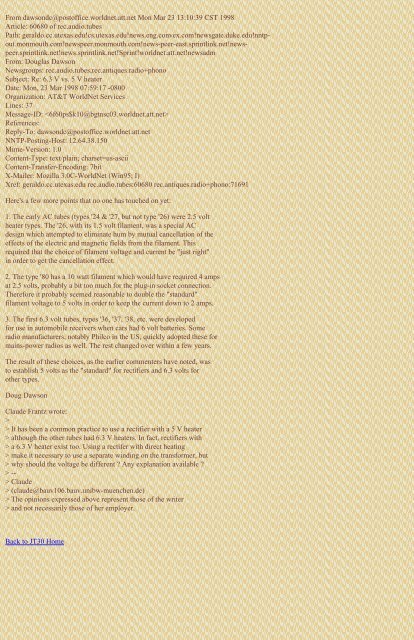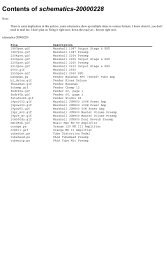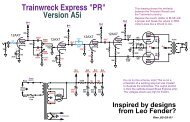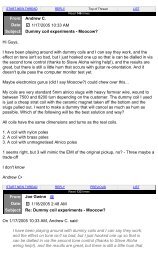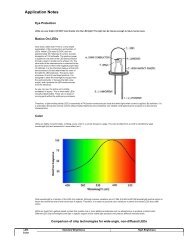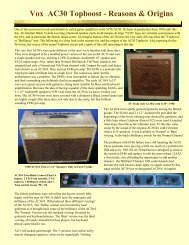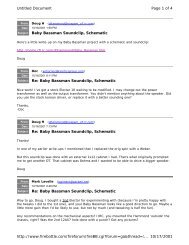Mic Kaczmarczik's TubeInformation - The Blue Guitar
Mic Kaczmarczik's TubeInformation - The Blue Guitar
Mic Kaczmarczik's TubeInformation - The Blue Guitar
You also want an ePaper? Increase the reach of your titles
YUMPU automatically turns print PDFs into web optimized ePapers that Google loves.
From dawsondc@postoffice.worldnet.att.net Mon Mar 23 13:10:39 CST 1998<br />
Article: 60680 of rec.audio.tubes<br />
Path: geraldo.cc.utexas.edu!cs.utexas.edu!news.eng.convex.com!newsgate.duke.edu!nntpout.monmouth.com!newspeer.monmouth.com!news-peer-east.sprintlink.net!newspeer.sprintlink.net!news.sprintlink.net!Sprint!worldnet.att.net!newsadm<br />
From: Douglas Dawson<br />
Newsgroups: rec.audio.tubes,rec.antiques.radio+phono<br />
Subject: Re: 6.3 V vs. 5 V heater<br />
Date: Mon, 23 Mar 1998 07:59:17 -0800<br />
Organization: AT&T WorldNet Services<br />
Lines: 37<br />
Message-ID: <br />
References:<br />
Reply-To: dawsondc@postoffice.worldnet.att.net<br />
NNTP-Posting-Host: 12.64.38.150<br />
Mime-Version: 1.0<br />
Content-Type: text/plain; charset=us-ascii<br />
Content-Transfer-Encoding: 7bit<br />
X-Mailer: Mozilla 3.0C-WorldNet (Win95; I)<br />
Xref: geraldo.cc.utexas.edu rec.audio.tubes:60680 rec.antiques.radio+phono:71691<br />
Here's a few more points that no one has touched on yet:<br />
1. <strong>The</strong> early AC tubes (types '24 & '27, but not type '26) were 2.5 volt<br />
heater types. <strong>The</strong> '26, with its 1.5 volt filament, was a special AC<br />
design which attempted to eliminate hum by mutual cancellation of the<br />
effects of the electric and magnetic fields from the filament. This<br />
required that the choice of filament voltage and current be "just right"<br />
in order to get the cancellation effect.<br />
2. <strong>The</strong> type '80 has a 10 watt filament which would have required 4 amps<br />
at 2.5 volts, probably a bit too much for the plug-in socket connection.<br />
<strong>The</strong>refore it probably seemed reasonable to double the "standard"<br />
filament voltage to 5 volts in order to keep the current down to 2 amps.<br />
3. <strong>The</strong> first 6.3 volt tubes, types '36, '37, '38, etc. were developed<br />
for use in automobile receivers when cars had 6 volt batteries. Some<br />
radio manufacturers, notably Philco in the US, quickly adopted these for<br />
mains-power radios as well. <strong>The</strong> rest changed over within a few years.<br />
<strong>The</strong> result of these choices, as the earlier commenters have noted, was<br />
to establish 5 volts as the "standard" for rectifiers and 6.3 volts for<br />
other types.<br />
Doug Dawson<br />
Claude Frantz wrote:<br />
><br />
> It has been a common practice to use a rectifier with a 5 V heater<br />
> although the other tubes had 6.3 V heaters. In fact, rectifiers with<br />
> a 6.3 V heater exist too. Using a rectifer with direct heating<br />
> make it necessary to use a separate winding on the transformer, but<br />
> why should the voltage be different ? Any explanation available ?<br />
> --<br />
> Claude<br />
> (claude@bauv106.bauv.unibw-muenchen.de)<br />
> <strong>The</strong> opinions expressed above represent those of the writer<br />
> and not necessarily those of her employer.<br />
Back to JT30 Home


